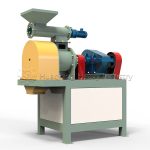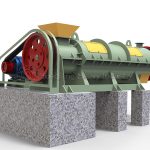Rotary Drum Granulator
Fertilizer Granulator Machine
Let’s Start Work
Together
Please feel free to contact us. We will get back to you with 1-2 business days. Or just call us now.




Rotary Drum Granulator
A rotary drum granulator is a granulation device that uses the rotation of a drum to aggregate materials into granules. It is widely used in the field of granule production. Its core operating principle is that the mixed material is fed into an inclined drum. Driven by a motor, the drum rotates, causing the material to tumble and collide within the drum due to the combined effects of gravity, friction, and centrifugal force . Simultaneously, a spray device applies an appropriate amount of water or binder to the material, moistening the surface of the material particles and bonding them together, gradually agglomerating them into granules of a certain strength and size.
This granulation method is a wet granulation method suitable for a wide variety of materials, producing granules with good sphericity and moderate strength. Compared to other granulation equipment, the rotary drum granulator has a high production capacity, enabling continuous large-scale production. Its simple structure and easy operation and maintenance make it a key player in the fertilizer and chemical industries.
Scope Of Application
Fertilizer field: It can produce various compound fertilizers, organic fertilizers, inorganic fertilizers, etc. It can mix basic fertilizers such as nitrogen, phosphorus, potassium in a certain proportion and granulate them to produce compound fertilizers with different nutrient contents to meet the needs of different crops and soils.
In organic fertilizer production, fermented organic materials such as livestock and poultry manure and straw can be processed into granular organic fertilizer, solving the problem of inconvenient transportation and application of organic fertilizer. At the same time, it can also be used in the production of bio-organic fertilizer. By properly controlling the granulation conditions, the activity of the biological bacteria can be better preserved.
Chemical industry: Suitable for granulation of various chemical raw materials, such as catalysts, pigments, detergents, etc. Through granulation, these chemical products have better fluidity, stability and performance, and are easy to store and transport.
Metallurgical Industry: It can be used to granulate metal ore powder, such as iron ore powder, manganese ore powder, etc. After the ore powder is made into granules, it is beneficial to improve sintering efficiency, reduce energy consumption, and improve the quality of metallurgical products.
Building materials industry: It can granulate cement raw materials, ceramsite sand and other building materials, improve the performance of raw materials, and enhance the quality and production efficiency of building materials.
Equipment Structure And Composition
Rotating Drum: It is the core working component of the drum granulator. It is usually a cylindrical barrel, welded with steel plates. The inner wall is generally paved with wear-resistant linings, such as rubber linings, polyurethane linings, etc., to reduce the wear of the material on the drum and extend its service life.The drum’s diameter and length vary depending on production capacity, with common diameters ranging from 1 to 5 meters and lengths from 3 to 10 meters. The drum is installed at an angle, with the tilt adjustable via a device, typically between 3° and 6°, to ensure smooth movement and tumbling of the material within the drum.
Transmission: The drum is composed of an electric motor, a speed reducer, gears, and rollers. The motor provides power, which, after being reduced by the speed reducer, drives the gears or rollers, which in turn drive the drum. The performance of the transmission directly affects the stability of the drum’s speed, which is generally adjustable within a range of 5-20 rpm.
Feeding device: It mainly consists of a hopper and a feeder, which are used to evenly and stably feed the material into the drum. Types of feeders include screw feeders and belt feeders. The appropriate feeding method can be selected according to the characteristics of the material to ensure that the material can enter the drum continuously and evenly.
Spray device: It consists of a water pipe, a water pump, and nozzles, and is used to spray water or a binder onto the material in the drum. The number and position of the nozzles can be adjusted according to the size of the drum and the distribution of the material to ensure that the material is evenly moistened, promoting the formation and growth of particles.
Discharging device: Located at the end of the drum, there is usually an inclined chute or conveyor belt, which is used to transport the finished particles from the drum to subsequent processes such as drying, cooling, screening, etc. The design of the discharge device must ensure smooth material transportation and avoid material blockage.
Working Principle
Raw material pretreatment: Various fertilizer raw materials are crushed and screened to achieve the particle size required for granulation, generally between 0.1 and 1 mm. For organic fertilizer raw materials, fermentation and composting are required to remove harmful substances and improve the fertility of the fertilizer.According to the recipe requirements, various raw materials are accurately measured to ensure that the proportions of each ingredient are accurate.
Mixing: Place the measured raw materials into the mixer and mix thoroughly to ensure uniform distribution of the ingredients. The mixing time is generally 5-15 minutes. The mixed materials should have good uniformity to ensure the quality of subsequent granulation.
Granulation: The mixed materials are added into the drum through the feeding device. The drum rotates under the drive of the transmission device, and the materials are constantly rolling and colliding in the drum. At the same time, the spray device sprays the materials with an appropriate amount of water or binder, so that the material particles gradually agglomerate into granules.During the granulation process, the drum speed, tilt angle, and amount of water or binder added need to be adjusted according to the granule formation to ensure granule quality and yield. Generally, the granule diameter can be controlled between 1-6 mm.
Drying: The finished pellets contain a high amount of moisture and need to be dried. The pellets are sent to a dryer and dried at a certain temperature (usually 80-150°C) to reduce the moisture content of the pellets to below 10% to prevent the pellets from clumping and deterioration.
Cooling and screening: The temperature of the particles after drying is high and needs to be cooled. Usually a cooler or cooling fan is used to cool the particles down to room temperature.The cooled particles are screened by screening equipment to separate particles that do not meet the requirements (too large or too small) and return them to the granulation system for re-granulation. The qualified particles enter the packaging process.
Package: Qualified granular fertilizers are packaged after being measured. The packaging materials can be woven bags, plastic bags, etc., which are convenient for storage and transportation.
Equipment Features
Large production capacity: The rotary drum granulator adopts a continuous production method and has a large single-machine production capacity. It can produce several tons to dozens of tons of fertilizer per hour, which can meet the needs of large-scale industrial production.
Good particle quality: The fertilizer particles produced have high sphericity, generally reaching more than 80%, smooth surface, uniform particle size, moderate strength, are not easy to break or clump during storage, transportation and use, and have good fluidity.
Wide material adaptability: It can process various fertilizer raw materials, whether inorganic raw materials, organic raw materials, or a mixture of the two, and can achieve good granulation effect. For some materials that are difficult to granulate, they can also be granulated smoothly by adding an appropriate amount of binder.
Easy to operate: The equipment has a simple structure, is easy to operate and master. The operator can effectively control the granulation process by simply adjusting the speed and tilt angle of the drum and the amount of water or binder added.
Stable and reliable operation: The transmission device and supporting structure of the rotary drum granulator are reasonably designed, with stable and reliable operation, low failure rate, small maintenance workload, and can ensure long-term continuous production.








